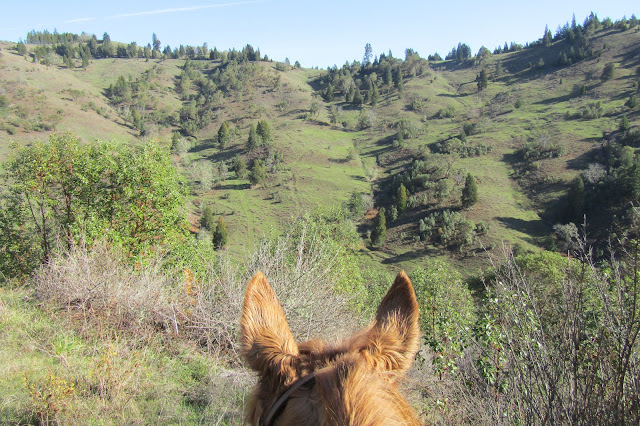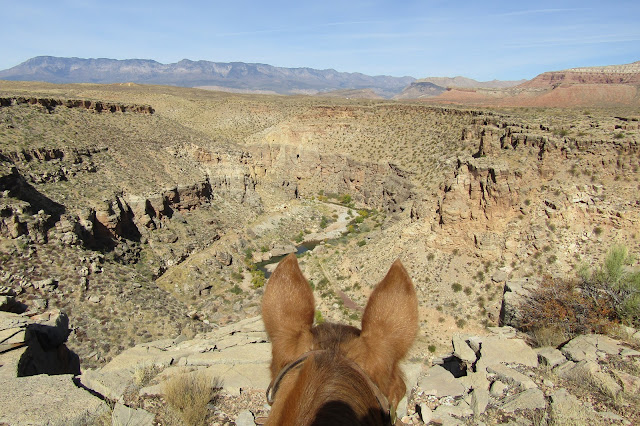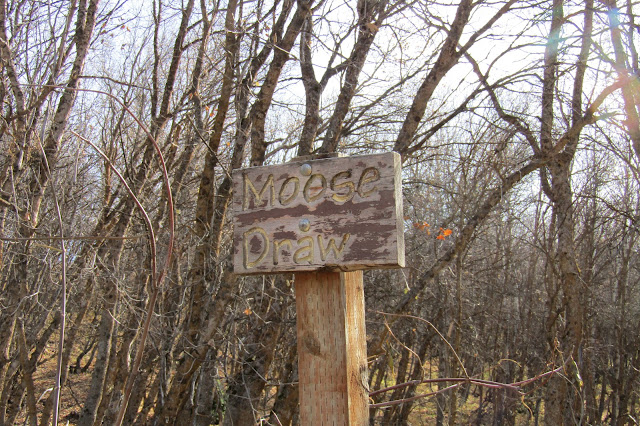Since there was only one horse camp there that I had not yet been to, I drove the 7 hours over to Sixes, Oregon.
 |
| The North Beach at Cape Blanco. |
I stopped at Floras Lake State Park just north of Cape Blanco, to ride to Blacklock Point and maybe further, if I had enough time. This trailhead is at the end of Airport Rd. which dead ends at an airport, not surprisingly, and the trail and small parking area is on the left. However there is also a nice large horse trailer friendly pullout on the right.
The trail follows beside the airport fence for awhile and then heads through the woods to the beach and consequently to the point. After checking out the views there, I got onto the Oregon Coast Trail which runs along the ridge. I followed it north for awhile but this is a hiking trail, and I knew from previous experience, that it has many non horse friendly areas, so it didn't take long before I had to turn around. Back near the airport there is an unmarked junction that will take you to Floras Lake, and I would have loved to have gone the whole way, but I could only follow that trail for a short time, or I was going to be setting up camp in the dark...darn time change!
 |
| On the trail to Blacklock Point. |
 |
| Blacklock Point. |
 |
| Blacklock Point. |
I then drove over to Cape Blanco State Park to the horse camp, which was totally empty.
Cape Blanco is a cute little camp with 8 sites in a loop. There are new steel corrals, a quite clean porta potty, garbage cans, 5 potable water spigots that you can attach a hose to, a manure bin and a grey water dump.
Spots #6 and #8 have four corrals and all the rest have two. #1, #6 and #8 are pull throughs, the others are back in, and site #3 is the smallest. The spots are lengthy enough to fit larger rigs but not wide enough for more than one, the exception being #4 which is wide enough for two rigs. You are also allowed to put up your own corrals to accommodate additional horses.
 |
| Cape Blanco Horse Camp. |
 |
| Cape Blanco Horse Camp. |
Like most coastal camps you can reserve a spot, and in the busy summer you would be extremely lucky to get a site without a reservation.
It is $17.00 per night, and there are no additional charges like most camps have for extra vehicles. If you don't have a reservation, you have to walk to the people campground nearby, to camp host site #50 where there is a self pay station.
The people campground has flush toilets and showers, which I was happy to take advantage of since I did not want to unwinterize my trailer.
 |
| Spot # 6 at Cape Blanco Horse Camp. |
The next day I left camp on the horse trail and headed south, there are around 7 miles of inland trails as well as a 150 acre open riding area across from camp. But the main goal, of course, is the beach so I went over to a viewpoint first, and then down onto the sand. It was sunny, the tide was out and there was no wind, which is a rarity at the coast. There were several curious seals watching me from the waves, they must really wonder what the heck kind of creature a horse is, with a rider, no less.
I always gallop when I am on the beach, so I did quite a lot of that. I headed north first to the point of the cape, passing Needle Rock. Then I went south until I reached Elk River. At the river there were quite a few fishermen, and I noticed one was just getting back into his car to leave the beach, so unbeknownst to him, I decided to race him... and I won!
 |
| Trail signage at Cape Blanco. |
 |
| A south beach viewpoint. |
 |
| On South Beach near Needle Rock. |
 |
| Cape Blanco and the lighthouse. |
After that I went back inland and rode around the perimeter fence line of the riding trails until I came to a dead end at the park road. From there I went up a trail that is deemed "extremely difficult", this just means that it is steep, and rode in the open riding area, meandering in and out of the woods for awhile.
 |
| The swampy area at the far east side of the trail system. |
 |
| Looking over to the Sixes River from the horse trail system. |
I'm not much for sitting still, so after my ride, which was pretty short, I went for a hike over to the lighthouse. The lighthouse and another attraction called The Hughes House, that I also walked to the following day, are fun places to visit and get tours of in the summer, however when I was there they were both closed for the winter.
 |
| The view down to the south beach where I had just ridden. |
 |
| The Cape Blanco Lighthouse. |
The next day I needed to find a way to get down to the beach on the north side of the cape, since you can't ride all the way around it. I started on the Oregon Coast Trail which I accessed by riding north on the camp road and then crossing the paved park road. I tried heading towards the Hughes House first, but the trail shortly became non horse friendly again. So I went the other way towards the lighthouse and made my way down to the beach from there. I was able to ride all the way back over to Blacklock Point, with the tide out and a spit of sand to follow between the ocean and the Sixes River. I also tried to ride the inland trails beside the river, but they were flooded and I didn't get very far.
 |
| On the Oregon Coast Trail. |
 |
| The North Beach. |
 |
| Riding on the North Beach. |
 |
| The spit of sand between the ocean and the Sixes River. |
 |
| Near the Sixes River. |
I went back to the Coast Trail and then followed it south, so I was looping back along beside the people campground and then over to the horse camp road. Although you are not allowed to ride along the paved roads, just crossing over them is probably okay, at least at the time of year that I was there, since it was pretty quiet, not much traffic or tourists to contend with.
There was someone parked in the camp when I got back, using an empty spot as day use.
After my ride, I went for a long walk over to the Pioneer Graveyard and the Hughes House. The Hughes House was built in 1898 and was once the home of a dairy farmer, and is now on the National Register of Historic Places.
 |
| On the Oregon Coast Trail heading south. |
 |
| The Hughes House. |
That evening as I was snug in my bed, I heard a strange noise coming from the back of my truck.... directly underneath me. At first I thought it was the wind knocking something over, but then there were some banging noises. It was pitch dark and I was not sure what I was dealing with, I had seen some deer earlier but I ruled them out pretty quickly. Then I remembered that I had left a container with senior equine in the back of my truck (which I never do), but once I heard it fall over I knew something was trying to get into it. Bear? I wasn't sure but I didn't want my truck to get all scratched up...priorities...so I went out and turned on my outside light. I saw something disappear off to the far side of my rig, so I went back into the trailer and shone my flashlight out my gooseneck window, right into the eyes of a portly raccoon who was staring right back at me.
After that I removed the tempting grain, and went back to bed, but of course the raccoon came back a little later when the coast was clear, and tried to find it again. I also heard him out there the following night, just in case I might have been complacent once more. All I can say is while he was hoisting himself up and over my tailgate, he was not particularly agile or graceful.
Early in the morning I got packed up, but instead of driving straight home, I took a little detour outside of Roseburg to the North Bank Habitat Management Area.
There are a couple of ways to access this large piece of BLM. Since it was a Saturday, I went to the Comstock Trailhead which is gated and only open Friday through Monday. The other way in, which is called the West Entrance is open all week.
The Comstock Trailhead has a bathroom and parking for quite a few horse trailers, in fact it was a busy place, and many more trailers arrived all through the day. There is a map you can look up online of all the trails, and also a large mapboard at the trailhead. They have a little covered manure bin where you can deposit any horse poop, which I thought was kind of nice, and certainly cuts down on the amount of times people just leave it in the parking lot.
 |
| The Comstock Trailhead at North Bank Habitat. |
There were some ladies getting ready to ride at the same time as me, in fact they invited me to join them, but I was kind of pressed for time, since I still had to drive all the way home. They had warned me about chiggers (a tiny type of mite) being a problem, so I fly sprayed my horse just in case. They left before me, but eventually I caught up and passed them. There are a couple of gates at the trailhead to go through, and depending on which one you pick, you will have a few different trails/roads to choose from, all of them going up into oak tree covered rolling hills.
I started on the Blacktail Basin Trail, then veered off for awhile on to the top of a ridge, then passed Grumpy's Pond and headed back down the Soggy Bottom Road passing the Wrong Way Trail!
I passed quite a few wildlife cameras set up in several different places. They are easy to spot, but pick your bathroom breaks carefully, or you will be on camera!
I am sure in the spring and summer there are numerous wild flowers, but although it was November the hills were still green, and it was very pretty. This is grazing land so there are quite a few gates to go through, and a lot of electric fence set up throughout the area. Since it is BLM you could technically camp on the land, but you can't camp at the trailhead, or drive onto the land, so that makes it pretty tricky to do so, unless you pack in.
 |
| Riding up the Blacktail Basin Trail, the two ladies are ahead of me. |
 |
| Views from the Blacktail Basin Trail. |
 |
| Scott Mountain. |
 |
| The junction with the Powerline Road. |
This area is popular for hunting, and I did see a few hunters when I left the parking lot, but not again for the rest of the day.
Once I got onto the Soggy Bottom Road I ran into another group of friendly riders, and as I headed back downhill, I could see where the name of that trail came about, since there was quite a lot of mud in the shaded areas.
 |
| Going down the Soggy Bottom Road. |
 |
| Lots of oak trees on the Soggy Bottom Road. |
It was a beautiful, warm and sunny day, and I would rather have continued exploring some of the other trails, but I had to think about getting home at a decent hour, so I kept my ride on the shorter side. I may have to go back another time and see the rest of the area. I got back home just in time for winter to finally kick in and snowfall to curtail my adventures... at least for a little while.
GPS COORDINATES TO BLACKLOCK POINT TH
GPS COORDINATES TO CAPE BLANCO
GPS COORDINATES TO COMSTOCK TH

























